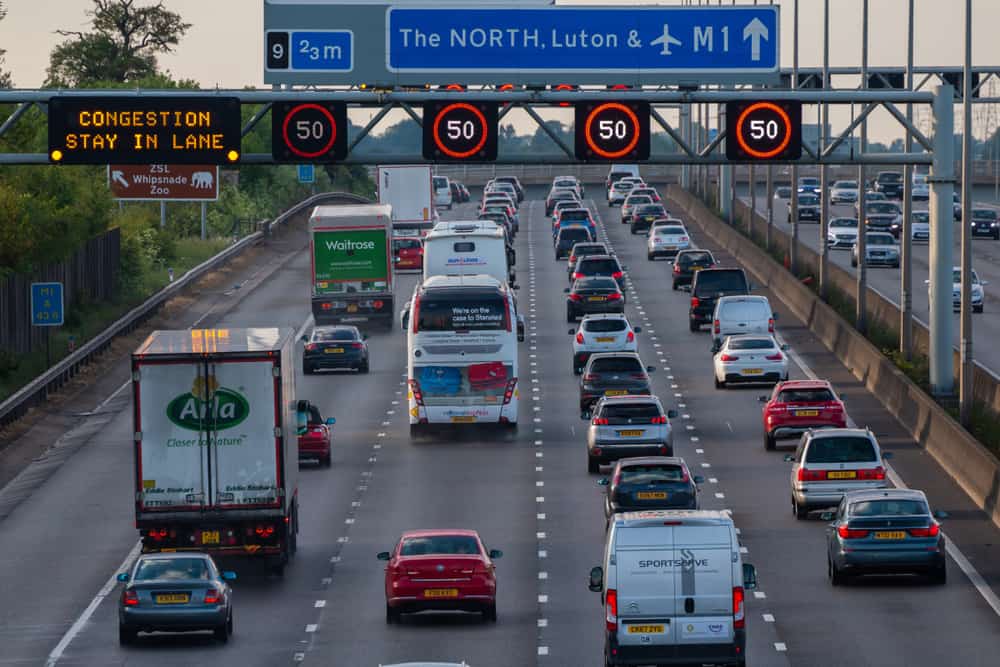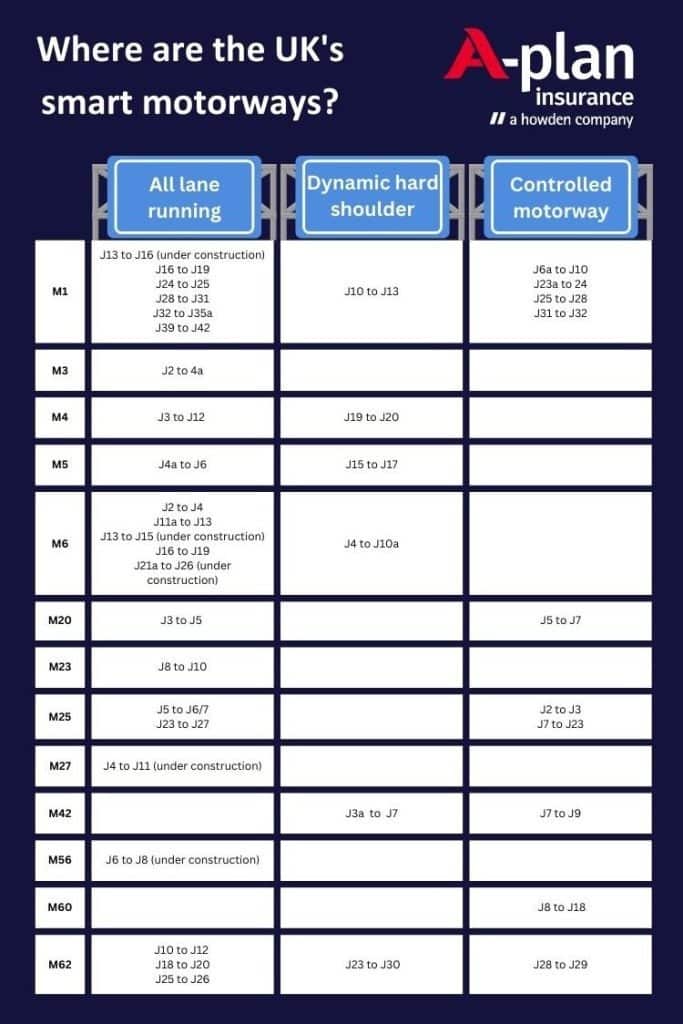Since plans for new smart motorways were cancelled recently, drivers have understandably had lots of questions. From what makes a smart motorway ‘smart’, how to use them, whether they are more dangerous and crucially, what happens next?
You may have driven on a smart motorway before, possibly without realising. Here, we explain the different types of smart motorway, where you can find them, and whether they’ll be changed back to ‘normal’ motorways.
What is a smart motorway?
Smart motorways are a type of highway that uses technology to improve traffic flow and reduce congestion. Launched by Highways England in 2006, smart motorways use lane-control systems, variable speed limits, the hard shoulder as a running lane, and other advanced technologies to keep vehicles travelling safely and efficiently.
Variable speed limits on a smart motorways are continuously monitored and adjusted in real-time to regulate vehicle speeds and reduce the risk of collisions. The lane-control systems allow for certain lanes to be open and closed to help manage congestion.
There are three types of smart motorway:
All lane running – The hard shoulder is permanently converted into a running lane AKA lane one. This lane (the former hard shoulder) is only closed to vehicles if there is an incident, signalled by a red X on an overhead gantry and/or on a verge-mounted sign. You must then exit the lane as soon as possible – ignoring the sign is unsafe and illegal.
The speed limit, displayed on surrounding signage, will vary depending on traffic conditions. If no speed limit is signalled, then the national speed limit applies.
Dynamic hard shoulder – Here, the hard shoulder can be opened and closed as a running lane depending on congestion. On these stretches of road, a solid white line distinguishes the hard shoulder from the normal carriageway, while overhead gantry signs indicate whether the hard shoulder is open to traffic.
Other variable messages will display ‘hard shoulder for emergency use only’ and a red X means you must exit the lane.
Controlled motorway – These have three or more lanes with variable speed limits, but the hard shoulder remains in place and should only be used in a genuine emergency. Again, overhead gantry signs display the variable speed limit, and the national speed limit applies if no speed limit is displayed.

Why have they been scrapped?
Smart motorways were developed as a system of managing traffic while minimising the environmental impact, time and cost of highway construction by avoiding the need to build additional lanes. Over 422 miles of smart motorway existed in 2020 and there had been plans to add a further 300 miles to the network.
But at the start of 2022 the Government paused further construction work, pending the results of a review into the cost and safety of smart motorways. Initially, the introduction of new smart motorways in Greater London, Manchester and across the Pennines were delayed. Now, they have been cancelled altogether.
How safe are smart motorways?
Smart motorways are controversial amongst motorists. The RAC’s 2022 Report on Motoring found that 70% of drivers believed no new ‘all lane running’ smart motorways should be introduced and wanted them switched to ‘dynamic hard shoulder’ motorways. What’s more, further research found that almost half of drivers (49%) avoid using lane one on ‘all lane running’ smart motorways. This revelation undermines the very reason for converting hard shoulders into permanently running lanes – increasing road capacity.
Many drivers question the safety of smart motorways, especially the variable speed limit forcing them to brake suddenly to reduce their speed in time or the general confusion of knowing when the hard shoulder is open for driving.
There are also concerns about Emergency Refuge Areas (ERAs), which are designed to offer a place of relative safety for stranded vehicles on roads without hard shoulders. They occur up to every 1.5 miles on ‘all lane running’ smart motorways and are now being painted orange for improved visibility.
However, one in four drivers with experience of driving on smart motorways are unaware of ERAs, according to the RAC, and one in five drivers that broke down on a smart motorway were unaware they should contact Highways England via the SOS telephone when using an ERA.
The BBC found that 38 people had died on smart motorways between 2014 and 2019, but also reported than the hard shoulder is itself a safety risk – one in 12 motorway deaths occur here.
Highways England reviewed the smart motorway changes since 2006 and found journey reliability improved by 22% and personal injury accidents have been reduced by more than half. Ultimately, there isn’t a huge amount of data available yet – though the Government’s decision is a definitive signal.
Will the hard shoulder be reintroduced?
All the proposed new smart motorways will no longer be built, though the M56 (junctions 6-8) and M6 (junctions 21a-26) will be completed as these are already ‘over three quarters constructed’. The £900m previously promised towards improving existing smart motorways will include 150 extra Emergency Refuge Areas and improved stopped vehicle detection technology on every all lane running section of road.
While a large majority (69%) of drivers want all lane running smart motorways converted back to traditional highways, the Government has said it won’t reinstate the hard shoulder on these roads, saying it would be too disruptive and costly. Experts have suggested converting all lane running sections into dynamic hard shoulder schemes, which are already in place on parts of the M42, M4 and M5 and have a good safety record. Here, the hard shoulder remains in place throughout most of the day and night and is only opened at times of peak traffic to help reduce congestion.

What are the rules on smart motorways?
All normal road rules and laws apply on smart motorways – but there are a few considerations to be aware of while you’re driving.
Speeding
The same laws and sentences apply for speeding on a smart motorway as a traditional motorway. However, with more cameras and variable speed limits on smart motorways, speeding motorists are more likely to be caught and fined. Speeding can lead to serious repercussions.
Many drivers don’t realise that smart motorway cameras can still catch you if you’re travelling over the national speed limit when a variable limit isn’t in place.
The red X
The red cross (X) symbol is displayed on the overhead gantries or on signs at the side of the road. The sign simply means ‘do not drive in the lane’, so if you see it on the lane you’re currently in, you need to exit as soon as it is safe to do so.
The red X indicates an incident, such as a breakdown, has occurred. Ignoring the sign is extremely dangerous; it can potentially cause serious injury to those at the incident plus the driver and passengers of the offending vehicle. You can be fined £100 and receive three points on your driving license for doing so.
Advice for driving on smart motorways
Highways England offers some guidance for using a smart motorway:
- Never drive in a lane closed by a ‘red X’.
- Keep to the speed limit shown on the gantries.
- A solid white line indicates the hard shoulder – never drive in it unless directed.
- A broken white line indicates a normal running lane.
- If your vehicle experiences difficulties, e.g. a warning light, exit the smart motorway immediately if possible and find a place of relative safety to stop.
Whatever roads you travel, or distance you drive, it’s important to find the right cover to suit you. Simply pop into your local branch to speak with one of our car insurance experts.
Read more about smart motorways.
Sources: Fleet World, RAC, BBC Panorama, Highways England
You could also read:
- Avoid fines when using smart motorways
- Smart motorways – What to do if you breakdown on one

